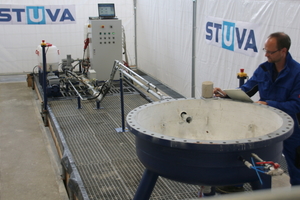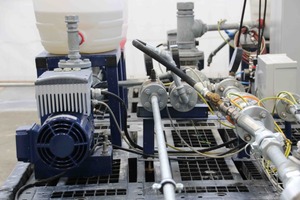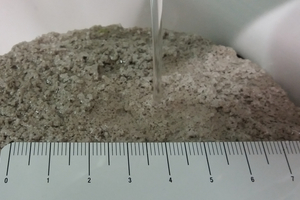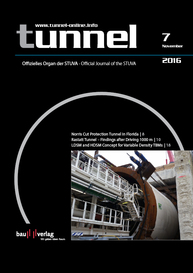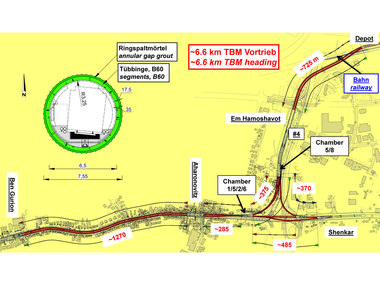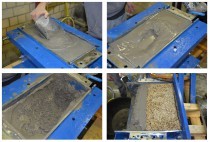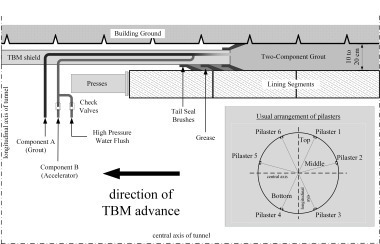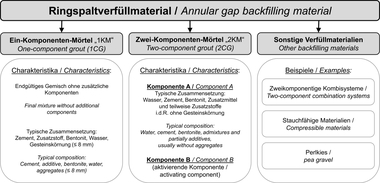New Test Stand
for annular Gap Mortars
A qualitatively high-grade tunnel lining requires the tunnel segment annular gaps to be properly grouted. At the same time, this provides a decisive contribution to a high rate of advance during mechanised excavation. The STUVA in Cologne has devised a complex and intricate unit for testing annular gap mortars in order to ensure that annular gap grouting is further optimised. In this way, the renowned Research Association for Tunnels and Transportation Facilities has again emphasized its significance in the field of R + D for constructing underground transportation facilities.
Complex annular Gap
Mortar Mixes
The annular gap between the segment lining and the surrounding soil, which results from the necessary overcut caused by a tunnel boring machine, is filled with annular gap mortar. Usually this comprises aggregate, cement, water and if need be, additives. The correct mix is based on reference values and is normally improved experimentally on-site by trial and error.
In recent years, the development of annular gap mortar – particularly using special products such as multi-component mortars – has become increasingly complex. After all, in the interim many substitutes and additives are being used, which were previously only applied for high-grade structural concretes:
Fly ashes and rock flours,
Accelerators to enhance the early setting strength,
Foamers to influence porosity and density or
Viscosity modifying admixtures (VMA) and plasticizers to adjust flowability.
Wide Range of Test Parameters
Thanks to the new STUVA test stand for annular gap grouting (Fig. 1) it is possible to examine conventional annular gap mortars. In addition, the influence of the individual components for innovative developments can be analysed systematically. In this way, targeted optimisations are feasible, which would otherwise be too complicated or time-consuming within the scope of site tests. The unit makes it possible for example to ensure that all mortar components are geared to one another in terms of volume and pressure and monitored metrologically (Fig. 2). Currently the STUVA test unit is geared to four components: the mortar or cement components can have up to two additives fed to them as well as compressed air dosed according to pressure and volume.
The test stand has a modular setup so that components can easily be replaced if need be. These include the grouting pumps, the delivery line cross-sections and also the additive feeding devices. Furthermore, the cross-section and lengths of the grout supply lines, through which the mortar is injected into the annular space during the excavation, can easily be varied. At the test stand these grout supply lines lead into a pressure tank. Here the counter-pressure in the actual annular space is simulated by means of artificial pressure, which can be actively influenced.
Furthermore, filter elements can be installed in the pressure tank so that the rock permeability is modelled and to investigate the effects of the mortar characteristics on the drainage conditions – aimed at early strength development. A special feature here involves the creation of specimens: these can be obtained under atmospheric pressure conditions as well as given counter-pressures of up to 10 bar.
Example of Application: Water-permeable annular Gap Mortar
At present, a water-permeable annular gap mortar is being developed using the new test unit with the financial support of the German Federal Ministry for Economic Affairs and Energy (BMWi). The application of a special mortar of this kind is always given during tunnelling in hard rock with high underground water pressures (on account of the high water pressures pressure-tight execution of the tunnel shell would lead to an excessively thick shell). The underground water is conducted through the water-permeable mortar (Fig. 3) externally passing the supporting, watertight segmental lining and run off at the bottom of the lining – in similar fashion to so-called umbrella seals employed during shotcreting. When a mortar of this kind is developed, it must be observed that it remains easily pumpable in spite of the high water permeability – two requirements, which actually directly oppose each other. The results obtained so far are highly promising.

